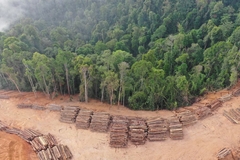Fonterra Focuses on Fewer Ports to Improve Supply Chain Efficiency
Fonterra said it was looking at consolidating its port usage as part of a drive towards greater efficiency in its supply chain for exports out of New Zealand.

14 Aug 2009 Fonterra’s General Manager Supply Chain Strategy, Nigel Jones, said the changes were about improving service to Fonterra’s global customers and reducing costs by moving containerised product away from indirect (feeder) services to direct export services.
He said the Co-operative had been discussing its plans with logistics service providers, and would be channelling greater export volumes of product out of the ports of Auckland, Tauranga, Lyttleton and Napier. As a result of these changes, Fonterra will reduce the volume of product moved through the ports of Taranaki and Timaru by 65% and 80% respectively.
While there would be an impact on ports which had less volume, Mr Jones said it was vital Fonterra had the most efficient, reliable and flexible links with its markets around the world.
“These changes are about making the best use of shipping services out of New Zealand and the country’s ports – to serve our customers and ultimately, through efficiencies, put more money in our farmers’ pockets.
“A good example is Port Taranaki. We’re moving from a position of having one indirect service to South East Asia per week to more than a dozen sailing options. That makes a lot of commercial sense when you’re managing tight inventory levels and delivery windows to customers.
“Historically there has been significant cross subsidisation of indirect services through regional ports by ocean carriers. And our customers are demanding ever increasing levels of service delivery.”
Mr Jones said other exporters would also potentially benefit from the continued investment and development of New Zealand’s ports and intermodal container transport systems.
He said this development would provide Fonterra with access to a greater variety of ocean carriers.
“New Zealand has seen a significant reduction in capacity and the consolidation of services by foreign lines, this development will reduce our exposure to potential freight rate increases.”
Efficient access to the ports was fundamental to the Co-operative’s supply chain strategy, and rail would play an important part, he said.
“Our increasing use of rail sits behind this move and reflects the greater level of confidence users have in the network post the recent ownership changes and creation of KiwiRail.”
Mr Jones said as the Government had previously indicated, it was up to exporters to lead the process of defining the country’s export infrastructure needs.
“As a country exporting 95% of our dairy production, New Zealand’s ongoing international competitiveness is dependent on its ability to connect directly with the major east-west trade flows to the large consumption markets in the US and Europe through Asia.
“In addition to the expected efficiency gains, we need a supply chain that is flexible and supports our strategy of providing the very best service to our customers globally, enabling us to grow with them.
“New Zealand can’t afford to find itself in a position where we don’t have a sustainable, cost effective ocean freight network, supported by highly efficient domestic transport infrastructure.”












